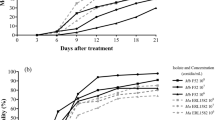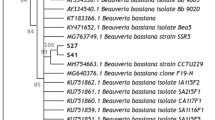Abstract
The efficacy of spot-spray application of conidia of Metarhizium anisopliae (Metsch.) Sorok. conidia formulated in an emulsifiable extract of Calpurnia aurea (Ait.) Benth in attracting and infecting Rhipicephalus appendiculatus Neumann, 1901 ticks was evaluated in semi-field experiments. Formulation was applied on a 900-cm² spot and ticks released from various distances. Attracted ticks were individually placed in glass vials to determine the number of M. anisopliae conidia picked by a single tick. Infected ticks were either transferred in glass vials or maintained in the laboratory until death or exposed to rabbits in order to investigate the effects of fungal infection on feeding and potential reproduction parameters. Data showed that individual ticks picked between 3.2 and 4.1 × 105 conidia. Mortality of 83 % was observed among ticks maintained in the laboratory conditions. The engorgement period of fungus-infected ticks significantly increased by 16 % compared to the control. A significant reduction (P < 0.0001) was recorded in body weight, egg-mass and egg hatchability from fungus-infected females. It is therefore possible to use M. anisopliae formulated in C. aurea extract for an integrated pest management approach. This study showed that conidia of M. anisopliae formulated in C. aurea extract are effective in attracting, infecting and causing mortalities of R. appendiculatus ticks. Moreover, the reproduction performance of fungus-infected females was significantly reduced.



Similar content being viewed by others
References
Aguirre DH, Viňabal AE, Salatin AO, Cafrune MM, Volpogni MM, Mangold AJ, Guglielmone AA (2000) Susceptibility to two pyrethroids in Boophilus microplus (Acari:Ixodidae) populations of northwest Argentina. Vet Parasitol 88:329–334
Barci LAG (1997) Biological control of the cattle tick Boophilus microplus (Acari, Ixodidae). Braz J Biol 64:95–101
Castro-Janer E, Rifran L, Gonzalez P, Piaggio J, Gil A, Schumaker TTS (2010) Rhicephalus (Boophilus) microplus resistance to fipronil in Uruguay evaluated by in vitro bioassays. Vet Parasitol 169:172–177
Ducornez S, Barré N, Miller RJ, de Garine-Wichatisky M (2005) Diagnosis of amitraz resitance in Boophilus microplus in New Caledonia with the modified Larval Packet Test. Vet Parasitol 130:285–292
Fernandes EKK, Bittencourt VREP, Roberts DW (2012) Perspectives on the potential of entomopathogenic fungi in biological control of ticks. Exp Parasitol 130:300–305
George JE, Pound JM, Davey RB (2004) Chemical control of ticks on cattle and the resistance of these parasites to acaricides. Parasitology 129:353–366
Gindin G, Samish M, Alekseev E, Glazer I (2001) The susceptibility of Boophilus annulatus (Ixodidae) ticks to entomopathogenic fungi. Biocontrol Sci Technol 11:111–118
Goettel MS (1984) A simple method for mass culturing entomopathogenic Hyphomycete fungi. J Microbiol Methods 3:15–20
Hoogstraal H, Aeschlimann A (1982) Tick-host specificity. Bull Soc Entomol 55:5–32
Hornbostel VL, Ostfeld SR, Zhioua E, Benjamen AM (2004) Sublethal effects of Metarhizium anisopliae (Deuteromycetes) on engorged larval, nymphal and adult Ixodes scapularis (Acari:Ixodidae). J Med Entomol 45:922–929
Inglis DG, Goettel MS, Butt TM, Strasser H (2001) Use of hyphomycetous fungi for managing insect pests. In: Butt TM, Jackson C, Magan N (eds) Fungi as biocontrol agents. CAB International, Wallingford, pp 23–69
Jongejan F, Uilenberg G (2004) The global importance of ticks. Parasitology 129:S3–S14
Kaaya GP, Hassan S (2000) Entomogenous fungi as promising biopesticides for tick control. Exp Appl Acarol 24:913–926
Kaaya GP, Mwangi EN, Ouna EA (1996) Prospects for biological control of livestock ticks, Rhipicephalus appendiculatus and Amblyomma variegatum, using the entomogenous fungi Beauveria bassiana and Metarhizium anisopliae. J Invertebr Pathol 67:15–20
Lacey LA, Goettel MS (1995) Current developments in microbial control of insect pests and prospects for the early 21st century. Entomophaga 40:3–27
Leemon DM, Turner LB, Jonsson NN (2008) Pen studies on the control of cattle tick Rhipicephalus (Boophilus) microplus with Metarhizium anisopliae (Sorokin). Vet Parasitol 156:248–260
Maniania NK, Nchu F, Ekesi S (2007) Fungal pathogen for biocontrol of ticks. In: Ekesi S, Maniania NK (eds) Use of entomopathogenic fungi in biological pest management. Research Signpost, Kerala, pp 275–294
Maniania NK, Okech MA, Adino JO, Opere JO, Ekesi S (2013) Transfer of inoculum of Metarhizium anisopliae between adult Glossina morsitans and effects of fungal infection on blood feeding and mating behaviors. J Pest Sci 86:285–292
Maranga RO, Hassanali A, Kaaya GP, Mueke JM (2006) Performance of a prototype baited trap in attracting and infecting the tick Amblyomma variegatum (Acari:Ixodidae) in field experiments. Exp Appl Acarol 38:211–218
Nana P, Maniania NK, Maranga RO, Boga HI, Kutima HL, Nchu F, Eloff JN (2010) Attraction response of adult Rhipicephalus appendiculatus and Rhipicephalus pulchellus (Acari: Ixodidae) ticks to extracts from Calpurnia aurea (Fabaceae). Vet Parasitol 174:124–130
Nana P, Maniania NK, Maranga RO, Boga HI, Kutima HL, Eloff JN (2012) Compatibility between Calpurnia aurea leaf extract, attraction aggregation, and attachment pheromone and entomopathogenic fungus Metarhizium anisopliae on viability, growth, and virulence of the pathogen. J Pest Sci 85:109–115
Nchu F, Maniania NK, Toure A, Hassanali A, Eloff JN (2009) The use of a semiochemical bait to enhance exposure of Amblyomma variegatum (Acari:Ixodidae) to Metarhizium anisopliae (Ascomycota:Hypocreales). Vet Parasitol 160:279–284
Nchu F, Maniania NK, Hassanali A, Eloff JN (2010a) Performance of a Metarhizium anisopliae-treated semiochemical-baited trap in reducing Amblyomma variegatum populations in the field. Vet Parasitol 169:367–372
Nchu F, Maniania NK, Hassanali A, Eloff JN (2010b) Optimizing modes of inoculation of Rhipicephalus ticks (Acari:Ixodidae) with a mitosporic entomopathogenic fungus in the laboratory. Exp Appl Acarol 51:373–382
Pell JK, Eilenberg J, Hajek AE, Steinkraus DC (2001) Biology ecology and pest management potential of Entomophthorales. In: Butt TM, Jackson C, Magan N (eds) Fungi as biocontrol agents: progress, problems and potential. CAB International, Wallingford, pp 71–153
Perinotto WMS, Angelo IC, Golo PS, Quinelato S, Camargo MG, Sá FA, Bittencourt VREP (2012) Susceptibility of different populations of ticks to entomopathogenic fungi. Exp Parasitol 130:257–260
Polar P, Moore D, Kairo MTK, Ramsubhag A (2008) Topically applied myco-acaricides for the control of cattle ticks: overcoming the challenges. Exp Appl Acarol 46:119–148
Pound JM, Miller JA, George JE, Fish D, Carroll JF, Schulze TL, Daniels TJ, Falco RC, Stafford KC, Mather TN (2009) The United States Department of Agriculture’s Northeast area-wide tick control project: summary and conclusions. Vector Borne Zoonotic Dis 9:439–448
Rot A, Gindin G, Ment D, Mishoutchenko A, Glazer I, Samish M (2013) On-host control of the brown dog tick Rhipicephalus sanguineus Latreille (Acari:Ixodidae) by Metarhizium brunneum (Hypocreales:Clavicipitaceae). Vet Parasitol 193:229–237
Samish M, Rehacek J (1999) Pathogens and predators of ticks and their potential in biological control. Annu Rev Entomol 44:159–182
SAS Institute (2001) SAS/STAT User’s guide: version 6, vol 1. SAS Institute, Cary, NC, USA
Schulze TL, Jordan RA, Krivenko AJ (2005) Effects of barrier application of granular deltamethrin on subadult Ixodes scapularis (Acari:Ixodidae) and nontarget forest floor arthropods. J Econ Entomol 98:976–981
Schumacher V, Poehling HM (2012) In vitro effect of pesticides on the germination, vegetative growth, and conidial production of two strains of Metarhizium anisopliae. Fungal Biol 116:121–132
Shipp JL, Zhang Y, Hunt DWA, Ferguson G (2003) Influence of humidity and greenhouse microclimate on the efficacy of Beauveria bassiana (Balsamo) for control of greenhouse arthropod pests. Environ Entomol 32:1154–1163
Souza LAD, Pires Júnior HB, Soares SF, Ferri PH, Ribas P, Lima EM, Furlong J, Bittencourt VREP, Perinotto WMS, Borges LMF (2010) Potential synergistic effect of Melia azedarach fruit extract and Beauveria bassiana in the control of Rhipicephalus (Boophilus) microplus (Acari:Ixodidae) in cattle infestations. Vet Parasitol 175:320–324
Vega FE, Dowd PF, Lacey LA, Pell JK, Jackson DM, Klein MG (2007) Dissemination of beneficial microbial agents by insects. In: Lacey LA, Kaya HK (eds) Field Manual of Techniques in Invertebrate Pathology, 2nd edn. Springer, Dordrecht, pp 127–146
Zimmermann G (2007) Review on safety of the entomopathogenic fungus Metarhizium anisopliae. Biocontrol Sci Technol 17:879–920
Acknowledgments
The first author received fellowship from the Bioscience Eastern and Central Africa Network (BecANet) and the Canadian International Development Agency (CIDA). The authors wish therefore to thank BecANet, CIDA, icipe and the curator of the Lowveld National Botanical Garden who gave permission for the collection of plant material. We also extend our gratitude to Drs K. Fiaboe and S. Subramanian for reviewing the manuscript, as well as Misses E. Ouna and B.A. Obonyo for their technical assistance.
Author information
Authors and Affiliations
Corresponding author
Additional information
Communicated by S.T. Jaronski.
Rights and permissions
About this article
Cite this article
Nana, P., Nchu, F., Ekesi, S. et al. Efficacy of spot-spray application of Metarhizium anisopliae formulated in emulsifiable extract of Calpurnia aurea in attracting and infecting adult Rhipicephalus appendiculatus ticks in semi-field experiments. J Pest Sci 88, 613–619 (2015). https://doi.org/10.1007/s10340-014-0637-8
Received:
Revised:
Accepted:
Published:
Issue Date:
DOI: https://doi.org/10.1007/s10340-014-0637-8




